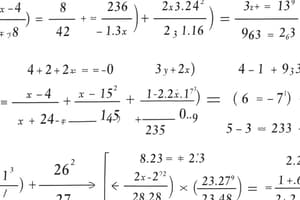Podcast
Questions and Answers
If A: B = 2:3 and B: C = 3:7, then A + B: B + C: C + A is?
If A: B = 2:3 and B: C = 3:7, then A + B: B + C: C + A is?
- 4:8:9
- 5:8:9
- 5:10:9 (correct)
- 4:10:9
If A: B = 1/2: 1/3 and B: C = 1/3: 1/5, then (A+B): (B+C) is equal to:
If A: B = 1/2: 1/3 and B: C = 1/3: 1/5, then (A+B): (B+C) is equal to:
- 5:8
- 9:10 (correct)
- 6:15
- 15/16
If A is 3/4 part of B, B is 1/2 part of C and C is 4/5 part of D then find value of A: B: C: D?
If A is 3/4 part of B, B is 1/2 part of C and C is 4/5 part of D then find value of A: B: C: D?
- 3: 5: 7: 10
- 2: 3: 7: 9
- 3: 5: 6: 9
- 3: 4: 8: 10 (correct)
If 2A = 3B = 4C, then A: B: C = ?
If 2A = 3B = 4C, then A: B: C = ?
Divide ₹7,800 amongst A, B, C and D so that A and B receives three times the part of C and D both. What is the share of A?
Divide ₹7,800 amongst A, B, C and D so that A and B receives three times the part of C and D both. What is the share of A?
What is the color of the image described?
What is the color of the image described?
Which of the following best describes the image?
Which of the following best describes the image?
What can be inferred about the visual information in the image?
What can be inferred about the visual information in the image?
What type of artwork could the described image represent?
What type of artwork could the described image represent?
In terms of graphic design, what effect does a black image typically convey?
In terms of graphic design, what effect does a black image typically convey?
Flashcards are hidden until you start studying
Study Notes
Ratio and Proportion Class Work Notes
- A and B have a ratio of 2:3, while B and C have a ratio of 3:7. The combined ratio A + B: B + C: C + A options include (A) 4:10:9, (B) 5:10:9, (C) 5:8:9, and (D) 4:8:9.
- In another scenario, A:B is given as 1/2: 1/3, and B:C is 1/3: 1/5. The resulting ratio of (A+B): (B+C) includes options like (A) 9:10, (B) 6:15, (C) 5:8, and (D) 15/16.
- If A is 3/4 of B, B is 1/2 of C, and C is 4/5 of D, the possible ratios for A: B: C: D are (A) 3:5:7:10, (B) 2:3:7:9, (C) 3:4:8:10, and (D) 3:5:6:9.
- Given the equation 2A = 3B = 4C, the ratios A: B: C can be derived into options (A) 2:4:3, (B) 6:4:3, (C) 5:2:10, or (D) None of these.
- To divide ₹7,800 among A, B, C, and D, A and B collectively receive three times the share of C and D. B's share equals four times that of C, and C's share is 1.5 times D's. Different options for A's share include (A) 1170, (B) 780, (C) 800, and (D) 1200.
- A total of ₹10,500 is distributed among A, B, and C, where A's share is 2/5 of the combined share of B and C, and B's share is half of A's.
Studying That Suits You
Use AI to generate personalized quizzes and flashcards to suit your learning preferences.



